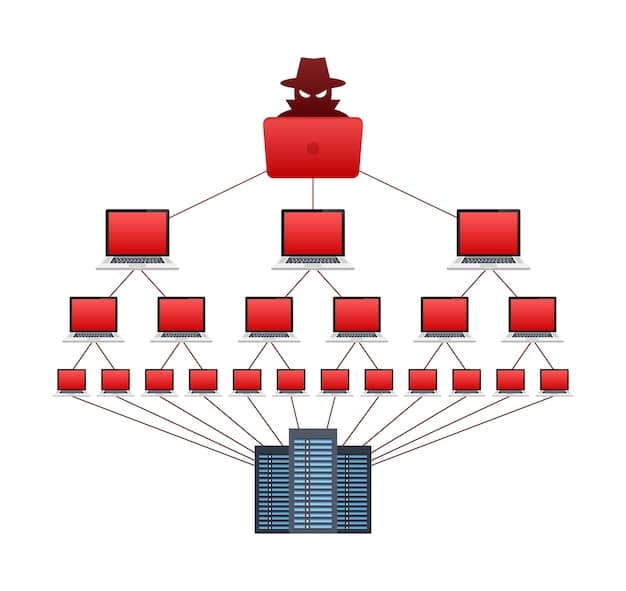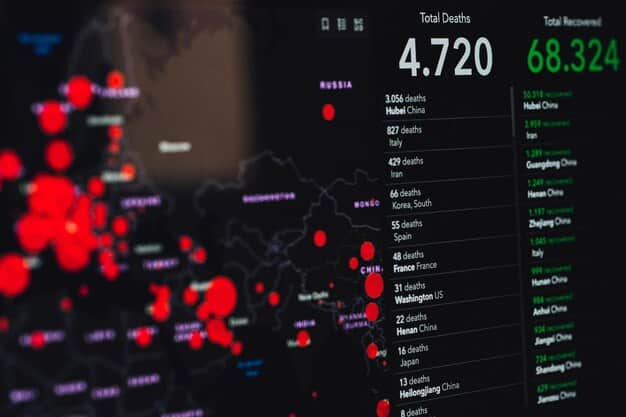Vulnerability Management: Protecting Your Fintech Systems

Vulnerability Management is crucial for fintech companies, involving identifying, assessing, and remediating security weaknesses in their systems to prevent cyberattacks and data breaches.
In today’s digital landscape, vulnerability management is not just a best practice, it’s a necessity, especially for fintech systems. These systems handle sensitive financial data, making them prime targets for cyberattacks. Understanding how to identify and remediate security weaknesses is vital for maintaining trust and protecting your assets.
Understanding Vulnerability Management in Fintech
Vulnerability management is the systematic process of identifying, classifying, remediating, and mitigating vulnerabilities in a system. In the fintech sector, this process is especially critical due to the high value and sensitivity of the data being handled.
Why Vulnerability Management Matters for Fintech
Fintech companies face unique challenges due to their reliance on technology and the regulatory scrutiny they are under. A single vulnerability can lead to significant financial losses, reputational damage, and legal consequences.
Key Components of Vulnerability Management
Effective vulnerability management includes regular assessments, timely patching, and robust security policies. It’s a continuous cycle of improvement rather than a one-time fix.
- Identification: Discovering vulnerabilities within the fintech system using various scanning tools and techniques.
- Assessment: Evaluating the severity and potential impact of identified vulnerabilities.
- Remediation: Implementing measures to fix or mitigate the vulnerabilities.
- Reporting: Documenting the entire process, including findings and actions taken.
By understanding these components, fintech companies can better protect themselves from potential threats and maintain the integrity of their systems.

Identifying Vulnerabilities in Fintech Systems
Identifying vulnerabilities is the first step in protecting your fintech systems. This involves using a combination of automated tools and manual assessments to uncover potential weaknesses.
Automated Vulnerability Scanning
Automated scanners can quickly identify common vulnerabilities across your infrastructure. These tools can scan for outdated software, misconfigurations, and other known issues.
Penetration Testing
Penetration testing, or ethical hacking, involves simulating real-world attacks to identify vulnerabilities that automated scanners might miss. This provides a more thorough assessment of your security posture.
- Network Penetration Testing: Focuses on identifying vulnerabilities in the network infrastructure.
- Application Penetration Testing: Examines the security of web and mobile applications.
- Social Engineering Testing: Assesses the vulnerability of employees to phishing and other social engineering attacks.
Regular penetration tests, performed by experienced professionals, are crucial for uncovering hidden vulnerabilities and ensuring the effectiveness of your security measures.
Assessing Vulnerability Risk in Fintech
Not all vulnerabilities are created equal. Assessing the risk associated with each vulnerability is crucial for prioritizing remediation efforts. This involves evaluating the likelihood of exploitation and the potential impact on your business.
Understanding Risk Assessment
Risk assessment is the process of identifying, analyzing, and evaluating risks. In the context of vulnerability management, this means understanding the potential impact of a vulnerability on your fintech system.
Factors to Consider in Risk Assessment
Several factors influence the risk associated with a vulnerability, including the severity of the vulnerability, the accessibility of the system, and the value of the data at risk.
Prioritizing Vulnerabilities
Prioritizing vulnerabilities based on risk allows you to focus your resources on the most critical issues first. This ensures that you are addressing the vulnerabilities that pose the greatest threat to your fintech system.
Effective risk assessment is essential for making informed decisions about vulnerability remediation. By understanding the potential impact of each vulnerability, you can prioritize your efforts and allocate resources effectively.
Remediating Security Weaknesses in Fintech
Remediating vulnerabilities is the process of fixing or mitigating the identified security weaknesses. This can involve patching software, reconfiguring systems, or implementing additional security controls.
Patch Management
Patch management is the process of applying updates and security patches to software and systems. Timely patching is crucial for addressing known vulnerabilities and preventing exploitation.
Configuration Management
Configuration management involves ensuring that systems are configured securely. This includes disabling unnecessary services, setting strong passwords, and implementing access controls.
- Regular Audits: Periodically review configurations to identify and correct any deviations from security standards.
- Automated Configuration Management Tools: Use tools to automate the process of configuring and maintaining systems.
- Secure Baselines: Establish secure configuration baselines for all systems.
By effectively managing your configurations, you can minimize the risk of exploitation and maintain a strong security posture.

Implementing a Vulnerability Management Program
A vulnerability management program is a structured approach to identifying, assessing, and remediating vulnerabilities. This includes establishing policies, procedures, and responsibilities for managing vulnerabilities throughout your fintech system.
Developing a Policy
A vulnerability management policy should outline the goals, scope, and responsibilities of the program. This provides a clear framework for managing vulnerabilities and ensures that everyone is on the same page.
Choosing the Right Tools
Selecting the right tools is essential for automating and streamlining the vulnerability management process. There are many vulnerability scanners, patch management systems, and configuration management tools available.
Training and Awareness
Training and awareness programs help employees understand the importance of security and how to identify and report vulnerabilities. This can significantly reduce the risk of human error and improve overall security.
Implementing a vulnerability management program is a critical step in protecting your fintech systems. By establishing clear policies, choosing the right tools, and providing adequate training, you can create a robust and effective vulnerability management process.
Best Practices for Fintech Vulnerability Management
Effective vulnerability management requires ongoing effort and adherence to best practices. This includes regular assessments, timely remediation, and continuous monitoring.
Regular Assessments
Regular vulnerability assessments are crucial for identifying new vulnerabilities and ensuring that existing vulnerabilities are being addressed. This can be done through automated scanning, penetration testing, and manual reviews.
Timely Remediation
Timely remediation is essential for minimizing the window of opportunity for attackers. This means patching software promptly, reconfiguring systems quickly, and implementing additional security controls as needed.
Continuous Monitoring
Continuous monitoring involves monitoring your systems for suspicious activity and potential vulnerabilities. This can help you detect and respond to attacks quickly, minimizing the potential impact.
By following these best practices, fintech companies can significantly improve their security posture and protect themselves from potential threats. Vulnerability management is an ongoing process that requires continuous effort and attention.
| Key Aspect | Brief Description |
|---|---|
| 🛡️ Identification | Discovering system vulnerabilities via scanning. |
| 🔍 Assessment | Evaluating the impact of vulnerabilities. |
| 🛠️ Remediation | Fixing or mitigating security weaknesses. |
| 📊 Monitoring | Continuous monitoring to detect and respond to attacks. |
Frequently Asked Questions
▼
Fintech systems handle sensitive financial data, making them prime targets for cyberattacks. Vulnerability management helps protect this data and maintain customer trust.
▼
The key components include identification, assessment, remediation, and reporting. These are all vital when creating and implementing a Vulnerability Management program.
▼
Vulnerability assessments should be performed regularly, ideally on a continuous basis. This allows you to stay ahead of potential threats and address vulnerabilities quickly.
▼
Penetration testing involves simulating real-world attacks to identify vulnerabilities. It is important because it provides a more thorough assessment of your security posture.
▼
Best practices include regular assessments, timely remediation, continuous monitoring, and employee training. Addressing all these aspects keeps your systems secure.
Conclusion
In conclusion, vulnerability management is an essential aspect of cybersecurity for fintech companies. By understanding the importance of vulnerability management, identifying and assessing risks, implementing effective remediation strategies, and following best practices, fintech companies can protect their systems and data from cyber threats.





